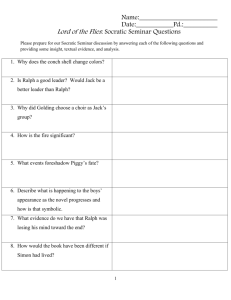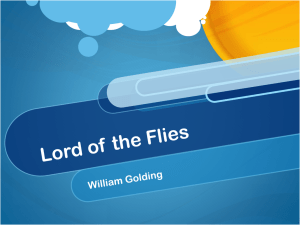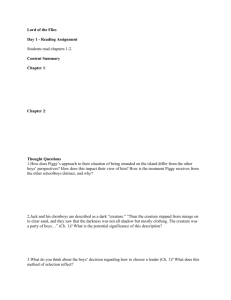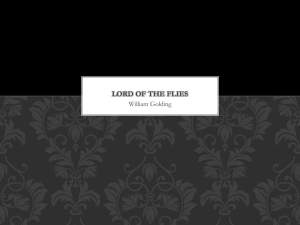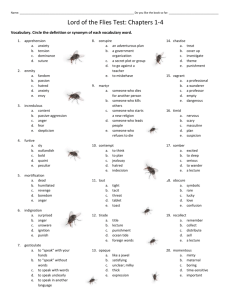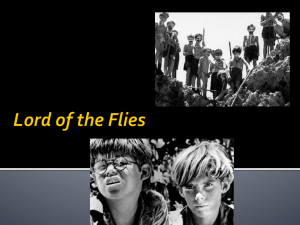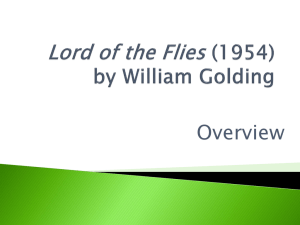Lord of the Flies - New Rochelle High School
advertisement
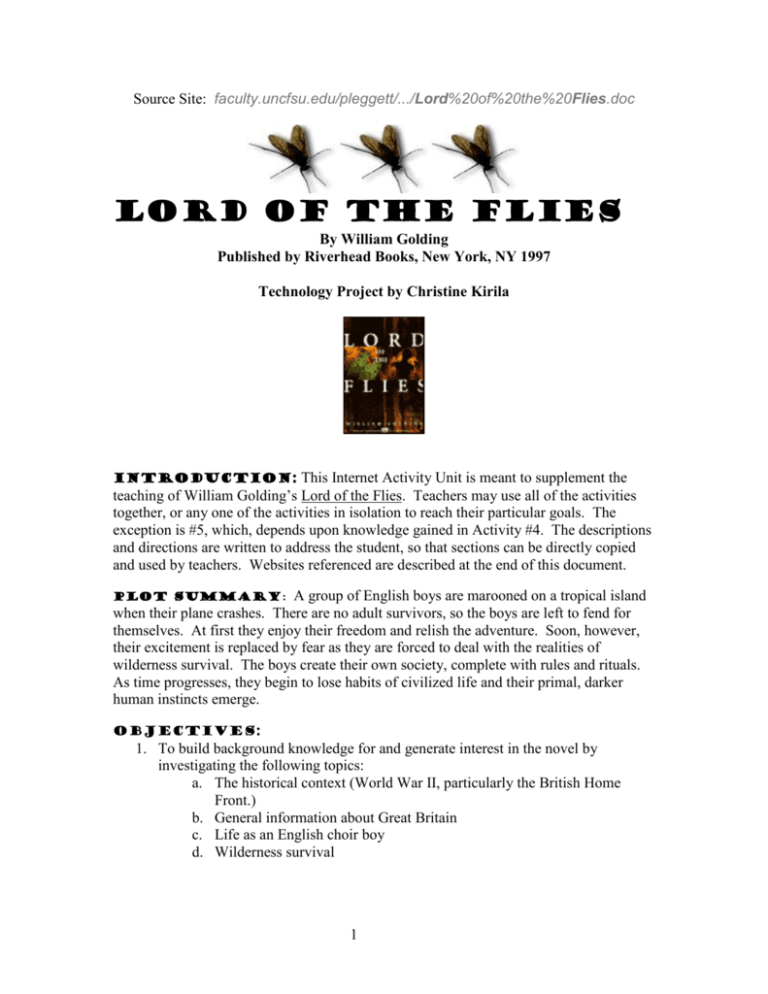
Source Site: faculty.uncfsu.edu/pleggett/.../Lord%20of%20the%20Flies.doc LORD OF THE FLIES By William Golding Published by Riverhead Books, New York, NY 1997 Technology Project by Christine Kirila Introduction: This Internet Activity Unit is meant to supplement the teaching of William Golding’s Lord of the Flies. Teachers may use all of the activities together, or any one of the activities in isolation to reach their particular goals. The exception is #5, which, depends upon knowledge gained in Activity #4. The descriptions and directions are written to address the student, so that sections can be directly copied and used by teachers. Websites referenced are described at the end of this document. Plot SUMMARY: A group of English boys are marooned on a tropical island when their plane crashes. There are no adult survivors, so the boys are left to fend for themselves. At first they enjoy their freedom and relish the adventure. Soon, however, their excitement is replaced by fear as they are forced to deal with the realities of wilderness survival. The boys create their own society, complete with rules and rituals. As time progresses, they begin to lose habits of civilized life and their primal, darker human instincts emerge. OBJECTIVES: 1. To build background knowledge for and generate interest in the novel by investigating the following topics: a. The historical context (World War II, particularly the British Home Front.) b. General information about Great Britain c. Life as an English choir boy d. Wilderness survival 1 2. To demonstrate an understanding of the novel in an ability to comprehend important ideas and details, interpret information, think critically, synthesize ideas and analyze the author’s use of language, style, purpose and perspective by: a. Presenting a Reader’s Theater production of a scene b. Identifying a hypothetical island that meets inferred contextual criteria c. Creating a symbolic flag and motto for the tribe d. Articulating personal reactions to literary passages e. Analyzing connections between music and pictures and the mood/tone of a literary passage 3. To write in a variety of formats for a variety of purposes including: a. An instructional brochure (technical document) b. A persuasive essay c. A personal letter d. A journal response 4. To use the internet to gain information, complete tasks and solve problems. Suggested schedule of activities: Before reading the novel Activity #1: Meet the Author While reading the novel Activity #2: Design a Survival Brochure (do early on) Activity #3: Impersonate a Chorister (do early on) Activity #4: Build a Context Activity #5: Present a Reader’s Theater Scene Activity #6: Reflect On an Image (do right before chapter 9) After reading the novel Activity #7: Find an Island Activity #8: Persuade a Producer (do after reading chapter 9) Activity #9: Create a Motto or Flag 2 ACTIVITIES: #1: MEET THE AUTHOR Knowing a little about the author can helps one to understand his purpose for writing, which in turn may further help to best appreciate a novel’s themes. Task: Access: http://www.geocities.com/Athens/Forum/6249/bio.htm to read about William Golding. Use the information you find to answer the questions below. Write your answers on a separate sheet of paper. The following sites will be helpful to you as well: http://kids.infoplease.lycos.com/search.php3?query=england http://www.nobel.se/literature/ (Hint: In the search prompt box type in key words that you want to search such as “British Commonwealth.”) Questions: 1. Golding is a native of what country? 2. What was his occupation during the 1940s? 3. Summarize his philosophy of human nature. 4. What event helped to shape this philosophy? 5. What is the Nobel Prize for literature? How does one earn it? 6. Differentiate between the following terms: Great Britain, England, the United Kingdom & the British Commonwealth 7. From what you know about Golding’s philosophy of human nature, what do you predict might happen to a group of boys marooned on a deserted island with no adult supervision? Keep these predictions handy. As you read the novel, see if they materialize. Evaluation: You will be evaluated according to your ability to successfully locate the answers to the above questions. 3 #2: Design a SURVIVAL BROCHURE (Technical Document) Task: (This may be done individually or in groups) The boys marooned on the island will be faced with the task of survival in the wilderness. Become an expert on one area of wilderness survival (shelters, food procurement, water procurement, signaling, psychology of survival or fire crafts). Explore the site below, and choose an area that interests you. Let your teacher know which you choose. As you read about this area, take notes on what you believe to be the most important information. Use your notes to create a brochure that would have been helpful to the boys on the island. Communicate your information in a logical way using drawings and graphs when necessary. The following site will help you: http://www.wilderness-survival.net/ Evaluation: You will be evaluated according to the criteria for a technical document found at this website: http://www.sdcoe.k12.ca.us/score/actbank/ttech.htm For Fun (Optional): Test your own knowledge of wilderness survival by taking the quiz posted at this website. Read up on areas where you are weak. Take the quiz by clicking on to: http://www.wilderness-survival.net/quiz/quiz.php #3: IMPERSONATE A CHORISTER (Personal letter) In Lord of the Flies, Jack is described as the head chorister, the leader of a group of choir boys. Recall the initial introduction of the choir boys in the novel: “Within the diamond haze of the beach something dark was fumbling along. Ralph saw it first, and watched till the intentness of his gaze drew all eyes that way. Then the creature stepped from mirage on to clear sand, and they saw that the darkness was not all shadow, but mostly clothing. The creature was a party of boys, marching approximately in step in two parallel lines and dressed in strangely eccentric clothing. Shorts, shirts, and different garments they carried in their hands; but each boy wore a square black cap with a silver badge on it. Their bodies, from throat to ankle, were hidden by black cloaks which bore a long silver cross on the left 4 breast and each neck was finished off with hambone frill. The heat of the tropics, the descent, the search for food and now this sweaty march along the blazing beach had given them the complexions of newly washed plums. They boy who controlled them was dressed in the same way though his cap badge was golden…” (Golding, William, Lord of the Flies. Riverhead Books, New York, New York: 1997, p.16.) Did you know that the tradition of boys’ choirs is a long-standing one throughout Europe and that to be a member is to hold a position of prestige? Access http://www.worcestercc.freeserve.co.uk/recordin.htm to read more about an English boy’s choir that performs today. This site will help you with the task below. Task: Imagine that you have just been selected as a member of the Worcester Cathedral Choir in England. Write a letter to a friend or relative in which you describe why you wanted to be in the choir, what process you had to go through to be selected, how you spend your day, and what you aspire to do in the choir. Evaluation: You will be evaluated on the criteria below: Your letter: ___is clear and purposeful, and addresses the intended audience appropriately ___highlights central ideas regarding the lifestyle of an English chorister ___follows the conventional style and format of a personal letter #4: BUILD A CONTEXT: WAR ON THE BRITISH HOMEFRONT From what was read earlier about William Golding, one can infer that his experience in the Royal Navy during World War II influenced his writings. Hints in Lord of the Flies also cause us to infer that the boys were evacuated from their homes during the war and it was in the process of this evacuation that their plane was shot down, leaving them stranded on the island. The following site will help you to build an understanding of life in Britain during World War II. This is a British-authored educational site. We normally learn history from the American perspective. It should be interesting to read from an authentic British source. You will enjoy this site. Task: Log on to: http://learningcurve.pro.gov.uk/homefront/default.htm Read each of the following sections: Evacuation, Gas, Internees, Home Guard, Spies. They will help you to answer the questions below. A. Evacuation: 1. Why were children evacuated from Britain in the 1940’s? 5 B. C. D. E. 2. Which countries offered to accept evacuees? 3. Why did the British public support oversees evacuation? 4. What caused the government to change its mind and discontinue the oversees evacuation policy? 5. How many children were evacuated or sent oversees from Britain or its colonies during World War II? Gas 1. By September of 1939, who had gas masks in Britain? Why? Internees 1. What is meant by the term “internee”? 2. Who was interned in Britain during World War II? Home Guard 1. Which was the last country in Europe to stand fighting against Germany (Hitler)? 2. What was “Dad’s Army”? Spies 1. What was meant by the slogan, “Keep mum. She’s not so dumb”? Why was it used? (Can you think of an American equivalent? 2. Who was Karel Richter? Evaluation: You will be graded according to your ability to demonstrate comprehension of ideas and details by answering the questions above. For fun (optional): While at each page above, click onto “activities” related to each section. These are games that will test your knowledge of what you read. They are fun! #5: PRESENT A SCENE (Reader’s theater) Task: In groups of four, select a scene from the novel that you believe is pivotal to the story. Create a Reader’s Theater script for this scene. Assign reading roles. Decide how to present the scene. (Consider tones, inflection, mood, emphasis and pauses in your delivery.) Practice your scene and present it to the class. Follow your presentation with an explanation as to why you chose this scene. Explain what you were trying to get across and the delivery choices you made to accomplish your task. The following websites will help you: Reader’s Theater directions: http://bms.westport.k12.ct.us/mccormick/rt/rtstudobj.htm Sample script: http://bms.westport.k12.ct.us/mccormick/rt/rtscripts/rtshobbit.htm Evaluation: You will be evaluated according to the criteria found at this website: http://bms.westport.k12.ct.us/mccormick/rt/rtstudobj.htm and according to your ability to work cooperatively as a member of a group. 6 #6: REFLECT ON AN IMAGE Task: Before reading Chapter 9, “A View to a Death,” take a look at the picture posted on http://www.cathedralchoir.net/ View it once again after completing the chapter, then complete the task below. Good readers create pictures in their heads as they read. This is one of the reasons why it can be easy to get lost in a book. It also can be one explanation for the comment, “The book was better than the movie.” Chapter nine of Lord of the Flies evokes some disturbing pictures. I don’t want to say any more, because I don’t want to interfere with the pictures fresh in your mind. Write a journal entry in which you describe the most memorable or striking pictures that appeared in your mind when reading this chapter. Next compare these pictures to the image viewed on the website above. Why do you think I asked you to view this picture in conjunction with this chapter? Evaluation: You will be evaluated on your ability to communicate a thoughtful, insightful written response and on your participation in class discussion of this topic. #7: FIND THE ISLAND Task: Use background information about World War II on the British home front as well as information from the novel to make an informed guess about where this story, had it been true, could have occurred. Find a real island on the globe that meets the criteria that you put together. Identify it on a map and then do the following: 1. Brainstorm (list) all the information that you know from the book about the island (physical description, climate, etc.). Be sure to record specific evidence from the text. 2. Brainstorm what you know about where evacuation planes were coming from and where they were going. 3. Form a theory about the general vicinity where this island could have been. Site specific references to the book and articles which support your theory. 4. Pick an island. (It may be a single island, named or un-named or a member of an archipelago.) 5. Print out a map that shows its location in relation to other surrounding recognizable places (oceans, continents). Color in the island. 7 6. Print out any information about the island. 7. Write a paragraph in which you explain why you chose this island. 8. Finally, find a flight from London to the largest city closest to your island. Print out the itinerary. Evaluation: You will be evaluated on your ability to navigate on the internet to find the information you need to complete the tasks above and on evidence of your careful reading, interpretation, critical thinking and ability to form a logical, thoughtful solution. The following sites may be of help to you: http://www.mamma.com/index.html?cb=Mama (a search engine) http://www.graphicmaps.com/aatlas/world.htm http://www.travelshop.de/english/airlines-e.html Good luck! #8: PERSUADE A PRODUCER Task: Pretend that you have been asked to select background music for a cinematic production of Lord of the Flies. Click on to http://www.worcestercc.freeserve.co.uk/recordin.htm. Click on “listen” next to the selection entitled, “Noel.” Play this song as you read the excerpt from the novel below. After so doing, write a persuasive essay in which you explain why this music would or would not be a good choice as background knowledge for this scene. If you determine that it is not, suggest some other music that you believe would be better. Tell whether or not you would use this piece somewhere in the movie and if so, where. Long before Ralph and Piggy came up with Jack’s lot they could hear the party. There was a stretch of grass in a place where the palms left a wide band of turf between the forest and the shore. Just one step down form the edge of the turf was the white, blown sand of above high water, warm, dry, trodden. Below that again was a rock that stretched away toward the lagoon. Beyond was a short stretch of sand and then the edge of the water. A fire burned on the rock and fat dripped from the roasting pig meat into the invisible flames. All the boys of the island, except Piggy, Ralph, Simon, and the two tending the pig, were grouped on the turf. They were laughing, singing, lying, squatting, or standing on the grass, holding food in their hands. But to judge by the greasy faces, the meat eating was almost done; and some held coconut shells in their hands and were 8 drinking form them. Before the party had started, a great log had been dragged into the center of the lawn and Jack, painted and garlanded, sat there like an idol. There were piles of meat on green leaves near him and fruit and coconut shells full of drink. Piggy and Ralph came to the edge of the grassy platform; and the boys, as they noticed them, fell silent one by one till only the boy next to Jack was talking. Then the silence intruded even there and Jack turned where he sat. For a time he looked at them and the crackle of the fire was the loudest noise over the droning of the reef. Ralph looked away; and Sam, thinking that Ralph had turned to him accusingly put down his gnawed bone with a nervous giggle. Ralph took an uncertain step, pointed to a palm tree, and whispered something inaudible to Piggy; and they both giggled like Sam. Lifting his feet high out of the sand, Ralph started to stroll past. Piggy tried to whistle. At this moment the boys who were cooking at the fire suddenly hauled off a great chunk of meat and ran with it toward the grass. They bumped Piggy, who was burnt, and yelled and danced. Immediately, Ralph and the crowd of boys were united and relieved by a storm of laughter. Piggy once more was the center of social derision so that everyone felt cheerful and normal. Jack stood up and waved his spear. “Take them some meat.” The boys with the spit gave Ralph and Piggy each a succulent chunk. They took the gift, dribbling. So they stood and ate beneath a sky of thunderous brass that rang with the storm-coming. Jack waved his spear again…. …Piggy touched Ralph’s wrist. “Come away. There’s going to be trouble. And we’ve had our meat.” There was a blink of bright light beyond the forest and the thunder exploded again so that a little un started to whine. Big drops of rain fell among them making individual sounds when they struck. “Going to be a storm,” said Ralph, “and you’ll have rain like when we dropped here. Who’s clever now? Where are your shelters? What are you going to do about that?” The hunters were looking uneasily at the sky, flinching from the stroke of the drops. A wave of restlessness set the boys swaying and moving aimlessly. The flickering light became brighter and the blows of the thunder were only just bearable. The littluns began to run about, screaming. Jack leapt on to the sand. “Do our dance! Come on! Dance!” He ran stumbling through the thick sand to the open space of rock beyond the fire. Between the flashes of lightning the air was dark and terrible; and the boys followed him, clamorously. Robert became the pig, grunting and charging at Jack, who sidestepped. The hunters took their spears, the cooks took spits, and the rest clubs of firewood. A circling movement developed and a chant. While Roger mimed the terror of the pig, the littluns ran and jumped on the outside of the circle. Piggy and Ralph, under the threat of the sky, found themselves eager to take a place in this demented but partly secure society. They were glad to pound the brown backs of the fence that hemmed in the terror and made it governable. “Kill the beast! Cut his throat! Spill his blood.” The movement became regular while the chant lost its first superficial excitement and began to beat like a steady pulse. Roger ceased to be a pig and became a hunter, so that the center of the ring yawned emptily. Some of the littluns started a ring on their own; and the complementary circles went round and round as though repetition would achiever safety of itself. There was the throb and stamp of a single organism. The dark sky was shattered by a blue-white scar. An instant later the noise was on them like the blow of a gigantic whip. The chant rose a tone in agony. “Kill the beast! Cut his throat! Spill his blood.” 9 Again the blue-white scar jagged above them and the sulphurous explosion beat down. The littluns screamed and blundered about, fleeing from the edge of the forest and one of them broke the ring of biguns in his terror. “Him! Him!” The circle became a horseshoe. A thing was crawling out of the forest. It came darkly, uncertainly. The shrill screaming that rose before the beast was like a pain. The beast stumbled into the horseshoe. “Kill the beast! Cut his throat! Spill his blood!” The blue-white scar was constant, the noise unendurable. Simon was crying out something about a dead man on a hill. “Kill the beast! Cut his throat! Spill his blood! Do him in!” The sticks fell and the mouth of the new circle crunched and screamed. The beast was on its knees in the center, its arms folded over its face. It was crying out against the abominable noise something about a body on the hill. The beast struggled forward, broke the ring and fell over the steep edge of the rock to the sand by the water. At once the crowd surged after it, poured down the rock, fell on to the beast, screamed, struck, bit, tore. There were no words and no movements but the tearing of teeth and claws. The clouds opened and let down the rain like a waterfall. The water bounded from the mountain-top, tore leaves and branches from the trees, poured like a cold shower over the struggling heap on the sand. Presently the heap broke up and figures staggered away. Only the beast lay still, a few yards form the sea. Even in the rain they could see how small a beast it was; and already its blood was staining the sand. “ (Golding, William, Lord of the Flies. Riverhead Books, New York, New York: 1997, p.170-175.) Evaluation: Your writing should include a well-defined thesis that makes a clear and knowledgeable judgment and you should support your argument with detailed evidence, examples, and reasoning. Finally, you should be sure to arrange details, reasons, and examples effectively, anticipating and answering reader concerns and counter-arguments.* (* Evaluation standards taken from the Schools of California Online Resources for Educators found at: http://www.score.k12.ca.us/) 10 #9: CREATE A FLAG & MOTTO FOR THE MAROONED TRIBE Task: Create a flag and motto for the marooned boys at the end of the novel. The flag and motto should symbolize the values of the model and perhaps reflect important themes of the book. Take a look at flags around the world. Access http://www.flags.net/indexa.htm. Check out Australia, Bermuda, Antigua, New Zealand, etc. What do you notice that these flags have in common? Why? Will you include it on your flag? In addition, log on to http://www.usscouts.org/flag/sealmotto.html to read about our national mottos. What values do they reflect? Your motto may be incorporated into the flag, or written beneath it. Be prepared to explain the choices you made in your design. Present your flag and explanation to the class. Evaluation: You will be evaluated according to the following standards: 1. You have developed an interpretation which exhibits careful reading and insight. 2. You have connected your own response to the themes of the novel and can site specific textual references that influenced your decision making. 3. You deliver your ideas clearly and effectively in your presentation. 11 WEB SITES AND DESCRIPTIONS http://www.geocities.com/Athens/Forum/6249/bio.htm This site gives biographical information about William Golding. http://kids.infoplease.lycos.com/search.php3?query=england The Fact Monster is a large, free reference site for kids. It is an atlas, almanac, dictionary and encyclopedia in an easy-to-use search format. http://www.nobel.se/literature/ This site provides information about the Nobel prize for literature. http://www.wilderness-survival.net/ This site contains material from US Army training manuals pertaining to wilderness survival skills. The readability level is appropriate for junior high kids. It was chosen for the variety and length of articles pertaining to wilderness survival. Posted on the site is a high interest quiz which tests one’s personal wilderness survival expertise. This works well as an anticipation guide for the articles. http://www.score.k12.ca.us/ This is the homepage for the State of California Online Resources for Educators. This is an amazing resource, which provides standards-based teaching tools for math, science, social studies and language arts including rubrics, study guides and much more. The second site listed is a rubric for writing technical documents. http://www.fransnet.clara.net/boychoirs/ http://www.cathedralchoir.net/ http://www.worcestercc.freeserve.co.uk/recordin.htm The first of these sites is an international directory of boys’ choirs. The second two are direct sites of two English boys’ choirs in operation today. Both give information about the lifestyle of choristers and methods for audition. The first site was selected for its homepage picture that paints such an innocent picture of young choristers. This contrasts dramatically with the description in Lord of the Flies of the boys as hunters towards the end of the novel. The Worcester site contains audio clips of the choir in concert. http://learningcurve.pro.gov.uk/homefront/default.htm Learning Curve is an on-line teaching resource, structured to tie in with the UK History National Curriculum. The Learning Curve contains a varied range of original sources including documents, photographs, film and sound recordings. The branch that I have bookmarked is an exhibition on life on the British home front during World War II. It icludes seven galleries that investigate topics including “Preparation for War,” “Evacuation”, “The Bombing of Britain”, “The Empire Home Front”, “Everyday Life”, 12 “Women at War” and “Spies.” This is my absolute favorite site that I have found! It is WONDERFUL! http://www.mamma.com/index.html?cb=Mama Mama.com is a search engine. http://www.graphicmaps.com/aatlas/world.htm This site allows users to find global destinations and print all sorts of maps worldwide. http://www.travelshop.de/english/airlines-e.html This site provides links to the homepages of hundreds of airlines worldwide. Students can browse this site to find hypothetical itineraries between destination around the world. http://bms.westport.k12.ct.us/mccormick/rt/RTHOME.htm This sites deals with the basics of Reader’s theater including topics such as how to use reader’s theater with students, how to adapt a script, sample adaptations and student actor objectives. http://www.flags.net/indexa.htm This is a site entitled “The World Flag Database.” It contains accurate pictures of flags around the world. Students type in the name of a flag and it appears. http://www.usscouts.org/flag/sealmotto.html This site concentrates on the history of the Great Seal of the United States and our national mottos: “In God We Trust” and “E Pluribus Unum.” It is an excellent resources for explaining the symbolism and intent behind each and will provide insight and structure for students to create their own symbols for the boys on the island. Web Sources of Pictures in this Document: Barnesandnoble,com llc. Picture of the Lord of the Flies book cover. Copyright 1997-2002. Found at http://www.barnesandnoble.com/ on 11/23/02. Batram, Graham. Picture of the compass. © 2002 The World Flag Database & Graham Bartram. Updated Tuesday, September 17, 2002. Found 11/23/02 at http://www.flags.net/indexa.htm. Picture of William Golding found 11/23/02 at: http://www.geocities.com/Athens/Forum/6249/bio.htm All other pictures found at Free Clip Art : http://www.1clipart.com/index.cfm 13 14
